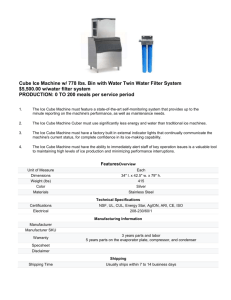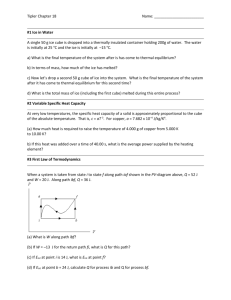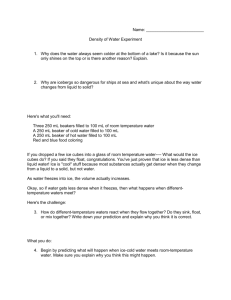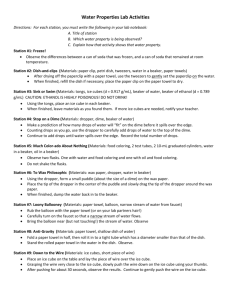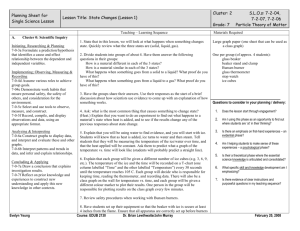density-driven-circulation-teachers-guide
advertisement
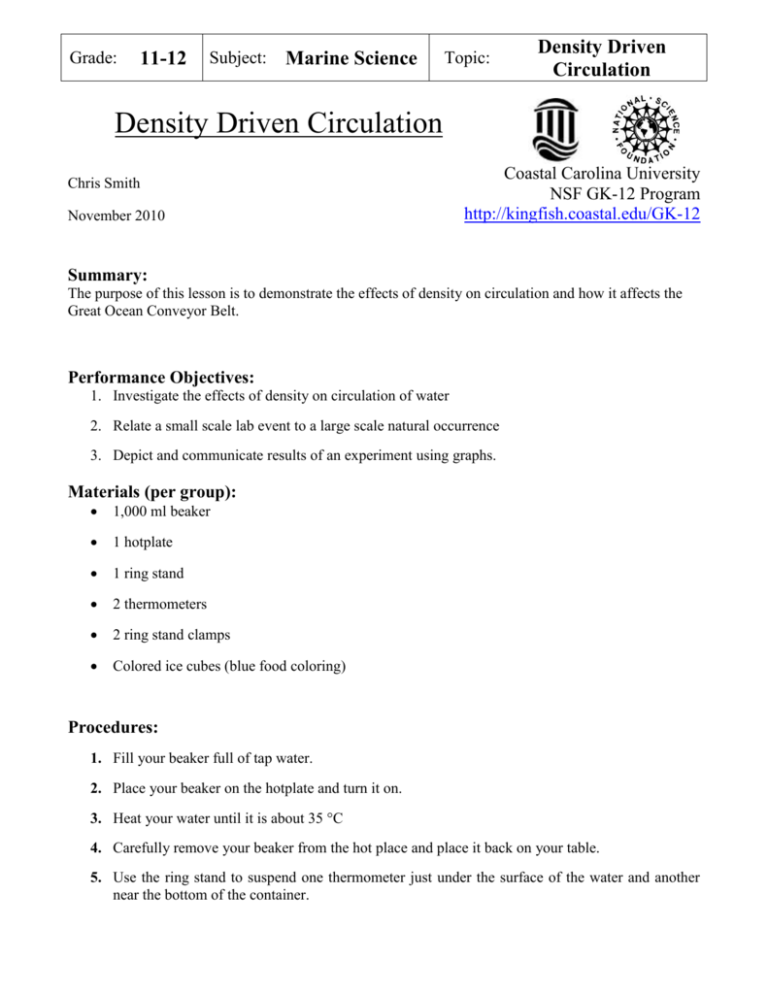
Grade: 11-12 Subject: Marine Science Topic: Density Driven Circulation Density Driven Circulation Chris Smith November 2010 Coastal Carolina University NSF GK-12 Program http://kingfish.coastal.edu/GK-12 Summary: The purpose of this lesson is to demonstrate the effects of density on circulation and how it affects the Great Ocean Conveyor Belt. Performance Objectives: 1. Investigate the effects of density on circulation of water 2. Relate a small scale lab event to a large scale natural occurrence 3. Depict and communicate results of an experiment using graphs. Materials (per group): 1,000 ml beaker 1 hotplate 1 ring stand 2 thermometers 2 ring stand clamps Colored ice cubes (blue food coloring) Procedures: 1. Fill your beaker full of tap water. 2. Place your beaker on the hotplate and turn it on. 3. Heat your water until it is about 35 °C 4. Carefully remove your beaker from the hot place and place it back on your table. 5. Use the ring stand to suspend one thermometer just under the surface of the water and another near the bottom of the container. 6. ALLOW 1-2 MIUNTES TO LET THE WATER SETTLE BEFORE PROCEEDING. Answer Question # 1 on the lab handout. 7. Gently drop 1 ice cube in the beaker. Observe the flows induced by the ice cube. Record what you see for Question # 2. 8. For the next 5 minutes, record both the surface and bottom temperatures and place them in the chart for Question # 3. 9. Pour out the water in the beaker and refill it with cool tap water. 10. Use the ring stand to suspend one thermometer just under the surface of the water and another near the bottom of the container. 11. ALLOW 1-2 MIUNTES TO LET THE WATER SETTLE BEFORE PROCEEDING. Answer Question # 5 on the lab handout. 12. Gently drop 1 ice cube in the beaker. Observe the flows induced by the ice cube. Record what you see for Question # 6. 13. For the next 5 minutes, record both the surface and bottom temperatures and place them in the chart for Question # 7. 14. Finally, clean up your work station and neatly place the materials to the side. Finish the remaining questions in preparation for a final discussion of the results QUESTIONS: Key 1. Predict what will happen when you put the ice cube into the warm water (not that it will just melt). Include what will happen to surface and water temperatures over the next 5 minutes. 2. Observe the flow that is created in the warm water by the ice cube. Record your observations here. The flow should be relatively quick, and flow from top of the beaker towards the bottom. 3. Record both the surface temperature and bottom temperature for the next 5 minutes in the table below. Minute Surface Temperature (°C) Bottom Temperature (°C) 1 2 3 4 5 4. Create a line graph that shows how both temperatures changed over the 5 minutes. Label both axis and include a title. Temperature (°C) Surface Bottom Time (minutes) 5. Predict what will happen when you put the ice cube into the cool water (not that it will just melt). Include what will happen to surface and water temperatures over the next 5 minutes. 6. Observe the flow that is created in the cool water by the ice cube. Record your observations here. The flow in the colder water should be slower than the warmer water flow. The color should stay near surface for a short time. 7. Record both the surface temperature and bottom temperature for the next 5 minutes in the table below. Minute Surface Temperature (°C) Bottom Temperature (°C) 1 2 3 4 5 8. Create a line graph that shows how both temperatures changed over the 5 minutes. Label both axis and include a title. Temperature (°C) Surface Bottom Time (minutes) 9. Is the cold water released by the melting ice cube more or less dense than the water in the beaker? How can you tell? The colder water is denser than the warmer water, because it sinks to the bottom 10. Was the speed of the flows faster in the warm or cool water? What do you think controls the speed of the flow? The flow was faster in the warmer water. The flow is controlled by the difference in density. 11. How does the flow you observed relate to the Great Ocean Conveyor Belt? The flow observed actually occurs at the poles and it is called down welling. 12. What would happen if the ocean conveyor belt were to stop? If the conveyor belt stopped, the Earth would go into an ice age. 13. How could you come up with a better way to make the water layered with in the container? Increase the difference in temperatures (ex. boiling water) or change the salinities of the ice cubes. Source: http://kingfish.coastal.edu/GK-12 http://www.nsfgk12.org

